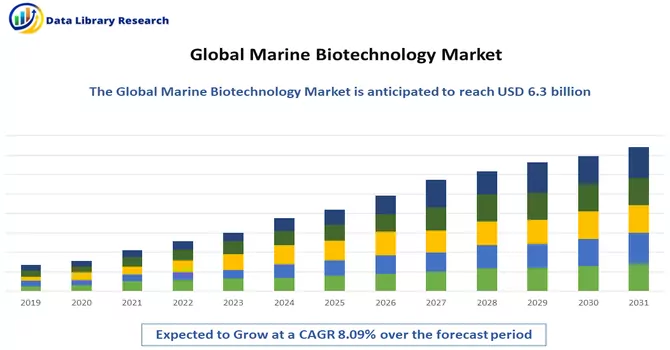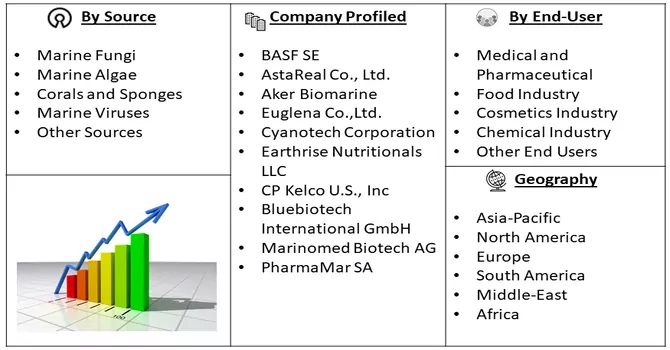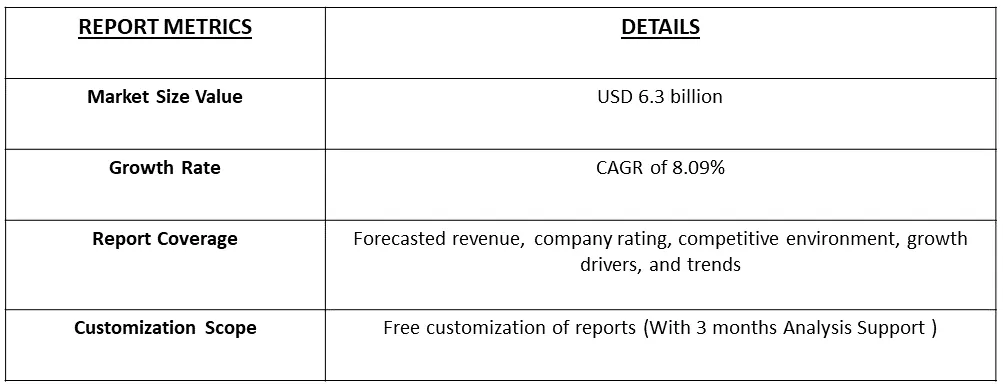The global marine biotechnology market size was reached at USD 6.3 billion in 2023 and it is projected to hit a CAGR of 8.09% during the forecast period from 2023 to 2031.

Get Complete Analysis Of The Report - Download Free Sample PDF
Marine biotechnology refers to the use of marine organisms, their derivatives, and their unique biochemical compounds for various applications in science, industry, and medicine. This interdisciplinary field combines principles of biology, chemistry, genetics, and oceanography to explore and harness the vast biodiversity found in marine environments. Marine biotechnology encompasses a wide range of activities, including the development of novel pharmaceuticals, biofuels, biomaterials, and enzymes, as well as applications in aquaculture, environmental monitoring, and bioremediation. Researchers in marine biotechnology study marine organisms such as algae, bacteria, fungi, and invertebrates to discover valuable compounds with potential benefits for human health, industry, and the environment. The unique and often extreme conditions of the marine environment offer a rich source of bioactive molecules and biological processes that can be leveraged for various biotechnological applications.
The marine biotechnology market is propelled by a myriad of factors driving innovation and development in this field. The rich biodiversity of marine organisms, encompassing microorganisms, algae, marine plants, and invertebrates, serves as a valuable source of unique biochemical compounds with applications in pharmaceuticals, nutraceuticals, and functional foods. Ongoing research has uncovered bioactive compounds from marine sources, leading to potential pharmaceutical discoveries for treating various diseases. Marine biotechnology also contributes to environmental solutions, including bioremediation and monitoring, and supports the sustainable growth of aquaculture through improved breeding and disease control techniques. Additionally, marine organisms, particularly microalgae, are explored for bioenergy production, contributing to the renewable energy landscape. Government initiatives and funding further stimulate research in marine biotechnology, fostering collaborations and advancements. The collective impact of these factors underscores the growing significance and potential of the marine biotechnology market.
The marine biotechnology market is characterized by dynamic trends shaping its trajectory. Bioprospecting in extreme environments, such as deep-sea hydrothermal vents, is yielding unique organisms adapted to harsh conditions, providing novel bioactive compounds. Advances in synthetic biology and genetic engineering empower the manipulation of marine organisms for desired traits, fostering innovation in creating genetically modified organisms for biotechnological applications. The application of metagenomics and omics technologies accelerates the comprehensive understanding of marine microbial communities, facilitating the identification of valuable biomolecules. The pursuit of marine-derived pharmaceuticals remains a prominent trend, with a focus on drug discovery for cancer, infectious diseases, and neurodegenerative disorders. Blue biotechnology is increasingly integrated into sustainable practices, particularly in aquaculture, addressing challenges in food production.
Market Segmentation: The Marine Biotechnology Market is segmented by Source (Marine Fungi, Marine Algae, Corals and Sponges, Marine Viruses, and Other Sources), End User (Medical and Pharmaceutical, Food Industry, Cosmetics Industry, Chemical Industry, and Other End Users), and Geography (North America, Europe, Asia-Pacific, Middle-East and Africa, and South America). The report offers the value (in USD million) for the above segments.

For Detailed Market Segmentation - Download Free Sample PDF
Market Drivers:
Increase in the Usage of Marine Organisms in the Pharmaceutical and Cosmetic Industries
The pharmaceutical and cosmetic industries are experiencing a notable surge in the utilization of marine organisms, marking a significant trend in recent years. Researchers and manufacturers in these sectors are increasingly exploring marine resources for their diverse bioactive compounds and unique properties. Marine organisms, such as algae, sponges, and other microorganisms, are being harnessed for their potential in developing pharmaceutical drugs and cosmetic products. The rich biodiversity of the oceans offers a vast array of novel compounds with various biological activities, including antimicrobial, anti-inflammatory, and antioxidant properties. The exploration of marine-derived ingredients aligns with the industries' pursuit of sustainable and natural sources for product development. This trend reflects a growing awareness of the untapped potential of marine organisms and their contribution to the development of innovative and environmentally friendly formulations in pharmaceuticals and cosmetics.
In a noteworthy development in July 2021, scientists at the National Institute of Ocean Technology in India successfully formulated an anti-aging ingredient for cosmetic applications, leveraging the unique properties of deep-sea bacteria. This breakthrough showcases the ongoing exploration of marine resources for innovative solutions in the cosmetic industry. Moreover, there is a growing market demand for marine-derived nutritional supplements, particularly in developed countries like the United States, Germany, and the United Kingdom. This increased demand underscores the global recognition of the nutritional and health benefits offered by marine organisms, driving further exploration and utilization in various industries, including cosmetics and pharmaceuticals. Thus, such factors are driving the growth of the studied market over the forecast period.
Increasing Demand for Marine-Derived Nutritional Supplements and Advancements in the Field of Fisheries and Drug Discovery
The escalating demand for marine-derived nutritional supplements and advancements in the fields of fisheries and drug discovery are shaping significant trends in the marine biotechnology sector. A notable surge in the popularity of nutritional supplements sourced from marine organisms is witnessed globally, with developed nations like the United States, Germany, and the United Kingdom leading the demand. This increasing interest is fueled by the recognized health benefits associated with marine-derived compounds. Concurrently, advancements in fisheries management and techniques are enhancing the sustainable extraction of marine resources for various applications. In the realm of drug discovery, marine biotechnology is making strides, exemplified by innovative research and product development. The exploration of marine organisms, such as seaweeds and deep-sea bacteria, is yielding novel bioactive compounds with potential applications in pharmaceuticals. These advancements underscore the growing recognition of the vast potential within marine ecosystems for addressing health, nutritional, and pharmaceutical needs. As research continues to uncover the diverse properties of marine organisms, the field of marine biotechnology is poised for further growth and contribution to human well-being.
In December 2022, TransGen Biotech Co., Ltd. introduced a novel product known as Uracil-DNA Glycosylase (Low Temperature). This recombinant protein is derived from psychrophile marine bacteria and serves the purpose of eliminating aerosol contamination resulting from polymerase chain reaction (PCR) products that contain deoxyuridine (dU). This innovative solution contributes to enhanced laboratory practices, specifically addressing the challenges associated with aerosol contamination during PCR processes involving dU-containing products. Thus, such factors are driving the growth of the studied market over the forecast period.
Market Restraints:
Lack of Exploration in Oceans and Limited Ability to Culture Marine Micro-organisms in Laboratories
The growth of the marine biotechnology market faces impediments due to the limited exploration of oceans and the challenges associated with culturing marine micro-organisms in laboratory settings. The vastness and complexity of the oceans pose significant hurdles in fully exploring and understanding the potential resources within marine ecosystems. The intricate nature of marine micro-organisms, coupled with the lack of comprehensive knowledge, restricts the ability to culture these organisms effectively in laboratory conditions. This limitation hampers the identification and extraction of valuable compounds for various applications in industries such as pharmaceuticals and cosmetics. Overcoming these challenges requires increased investment in ocean exploration, advanced research methodologies, and innovative techniques for the cultivation of marine micro-organisms, which, in turn, can propel the growth of the marine biotechnology market.
The marine biotechnology industry faced disruptions in demand and production during the initial phase of the COVID-19 pandemic. Nevertheless, the crisis provided an opportunity for the production of marine-derived supplements, given their potential health benefits against COVID-19. Notably, various marine algae species were explored for bioactive metabolites with antiviral and immunomodulatory properties, as reported in a February 2022 article in the Journal of Antioxidants. The heightened usage of marine-derived supplements during the pandemic had a significant impact on market growth. As the number of COVID-19 cases decreased, the marine biotechnology market has regained stability and is poised for continued growth in the forecast period.
Segmental Analysis:
Marine Fungi Segment to Hold a Significant Market Share Over the Forecast Period
Marine fungi play a pivotal role in the field of marine biotechnology, contributing to diverse applications across various industries. These fungi, adapted to marine environments, are rich sources of bioactive compounds with pharmaceutical, agricultural, and industrial significance. Researchers have explored marine fungi for their potential in drug discovery, uncovering novel compounds with antimicrobial, anti-inflammatory, and anticancer properties. Additionally, marine fungi exhibit enzymatic capabilities that hold promise for industrial processes, such as biofuel production and waste remediation. The unique adaptations of marine fungi to extreme conditions in the ocean contribute to their resilience and the synthesis of specialized metabolites. As a result, marine biotechnology harnesses the potential of these fungi for innovative solutions in medicine, agriculture, and industrial applications. The ongoing exploration of marine fungi underscores their importance as valuable resources in the realm of marine biotechnology, driving advancements and discoveries that have far-reaching implications across multiple sectors.
Cosmetics Industry Segment to Hold a Significant Market Share Over the Forecast Period
The cosmetics industry has increasingly turned to marine biotechnology for innovative and sustainable solutions. Marine organisms, including algae, microorganisms, and other marine-derived ingredients, offer a rich source of bioactive compounds with beneficial properties for skincare and cosmetic formulations. Algae, in particular, are prized for their high content of vitamins, minerals, and antioxidants, providing moisturizing, anti-ageing, and protective benefits to the skin. Marine biotechnology contributes to the development of novel cosmetic ingredients and formulations that address specific skincare needs. Compounds derived from marine sources, such as peptides, polysaccharides, and pigments, are incorporated into products like moisturizers, serums, and sunscreens. Additionally, the sustainable and eco-friendly nature of marine biotechnology aligns with the growing consumer demand for environmentally conscious beauty products. The exploration of marine resources for cosmetic applications highlights the industry's commitment to innovation, sustainability, and the pursuit of unique, nature-inspired ingredients. As the cosmetics sector continues to embrace marine biotechnology, it fosters a synergy between science and beauty, offering consumers effective and ethically sourced products.
Europe Region to Hold a Significant Market Share Over the Forecast Period
Europe is poised to maintain a significant market share in the marine biotechnology sector, driven by government initiatives promoting the utilization of natural marine products and available funding for their development, particularly in Germany. A notable example is Bluu Biosciences, a German biotech firm, securing nearly EUR 7 million to advance the production of high-quality, sustainable fish products through cell cultures. The region benefits from sophisticated healthcare infrastructure, continuous technological advancements in marine biotechnology, and a rising demand for marine organisms in the pharmaceutical and cosmetic industries. Sea4Us, a company focusing on developing a non-opioid analgesic from marine bioproducts, exemplifies the innovative projects supported by the European Commission. With substantial marine farming operations in Europe and the convergence of these favourable factors, the growth trajectory of the marine biotechnology market in Europe is expected to remain robust.

Get Complete Analysis Of The Report - Download Free Sample PDF
Major market players actively pursue strategies such as expanding their production capabilities, engaging in mergers and acquisitions, and conducting research and development initiatives to maintain a competitive edge in the industry. This involves increasing their capacity for manufacturing, acquiring other companies or merging with them to strengthen their market position, and investing in innovative research and development efforts. These strategic moves are crucial for staying ahead of competitors, enhancing market share, and ensuring sustained growth in the dynamic business environment. The commitment to these initiatives underscores the players' proactive approach in adapting to market trends, meeting evolving customer demands, and securing a prominent position in the competitive landscape. The key market players in the studied market are:
Recent Developments:
1) In October 2023: The Gandhian Institute of Technology and Management (GITAM, deemed to be university) has successfully obtained a grant of Rs 13.69 crore from the Department of Science and Technology (DST), Ministry of Science and Technology. This funding is designated for the establishment of a center focused on drug discovery and marine biology research. The grant is part of the Promotion of University Research and Scientific Excellence (PURSE) program by the department and will be utilized for acquiring new equipment, covering research expenses, supporting manpower, and organizing workshops and summer schools.
2) In December 2022, The CadalminTM LivCure extract, a nutraceutical product developed by the ICAR-Central Marine Fisheries Research Institute (CMFRI) from seaweeds to address non-alcoholic fatty liver disease, is set to be available in the market soon. An agreement has been reached between CMFRI and Emineotech, a private company specializing in health products, for the commercial production and marketing of the product. The license agreement was signed by CMFRI Director A. Gopalakrishnan and Evanjalist Pathrose, the managing director of Emineotech,
Q1. What was the Marine Biotechnology Market size in 2023?
As per Data Library Research the global marine biotechnology market size was reached at USD 6.3 billion in 2023.
Q2. At what CAGR is the Marine Biotechnology market projected to grow within the forecast period?
Marine Biotechnology Market is projected to hit a CAGR of 8.09% during the forecast period.
Q3. What segments are covered in the Marine Biotechnology Market Report?
By Source, End-User and Geography these segments are covered in the Marine Biotechnology Market Report.
Q4. Which region has the largest share of the Marine Biotechnology market? What are the largest region's market size and growth rate?
Europe has the largest share of the market. For detailed insights on the largest region's market size and growth rate request a sample here.
Data Library Research are conducted by industry experts who offer insight on industry structure, market segmentations technology assessment and competitive landscape (CL), and penetration, as well as on emerging trends. Their analysis is based on primary interviews (~ 80%) and secondary research (~ 20%) as well as years of professional expertise in their respective industries. Adding to this, by analysing historical trends and current market positions, our analysts predict where the market will be headed for the next five years. Furthermore, the varying trends of segment & categories geographically presented are also studied and the estimated based on the primary & secondary research.
In this particular report from the supply side Data Library Research has conducted primary surveys (interviews) with the key level executives (VP, CEO’s, Marketing Director, Business Development Manager and SOFT) of the companies that active & prominent as well as the midsized organization
FIGURE 1: DLR RESEARH PROCESS

Extensive primary research was conducted to gain a deeper insight of the market and industry performance. The analysis is based on both primary and secondary research as well as years of professional expertise in the respective industries.
In addition to analysing current and historical trends, our analysts predict where the market is headed over the next five years.
It varies by segment for these categories geographically presented in the list of market tables. Speaking about this particular report we have conducted primary surveys (interviews) with the key level executives (VP, CEO’s, Marketing Director, Business Development Manager and many more) of the major players active in the market.
Secondary ResearchSecondary research was mainly used to collect and identify information useful for the extensive, technical, market-oriented, and Friend’s study of the Global Extra Neutral Alcohol. It was also used to obtain key information about major players, market classification and segmentation according to the industry trends, geographical markets, and developments related to the market and technology perspectives. For this study, analysts have gathered information from various credible sources, such as annual reports, sec filings, journals, white papers, SOFT presentations, and company web sites.
Market Size EstimationBoth, top-down and bottom-up approaches were used to estimate and validate the size of the Global market and to estimate the size of various other dependent submarkets in the overall Extra Neutral Alcohol. The key players in the market were identified through secondary research and their market contributions in the respective geographies were determined through primary and secondary research.
Forecast Model
